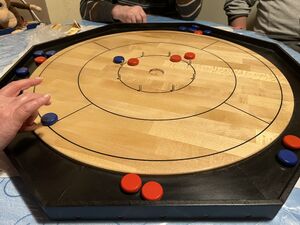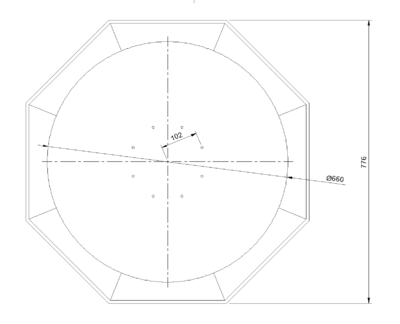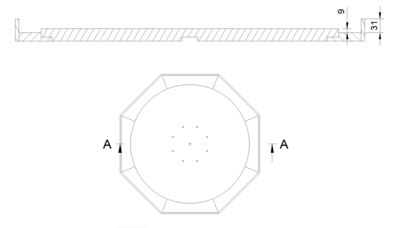Project:Crokinole: Difference between revisions
Created page with "Coming Soon!" Tags: Visual edit mobile edit mobile web edit |
|||
| (5 intermediate revisions by the same user not shown) | |||
| Line 1: | Line 1: | ||
Crokinole is a 2-4 player dexterity board game with the goal to get as many disks as close to the center as possible. For the detailed game rules check out the [https://en.wikipedia.org/wiki/Crokinole Crokinole Wikipedia page]. | |||
{{ProjectInfoBox|project title=Crokinole Board|status=done|initiator={{P}}|date=24.12.2021|materials=Wood (beech), Coloured MDF (Valchromat)|image=Crokinole Spielen.jpeg}} | |||
=== Design === | |||
The playing area of a Crokinole Board is 660mm in diameter. Dimensions for the other measurements were a bit harder to find and I took them from the [http://stephenhouser.com/crokinole blog of Stephen Houser]. | |||
{| class="wikitable" | |||
|Playing circle | |||
|660 mm | |||
|- | |||
|Outer line | |||
|610 mm | |||
|- | |||
|Middle line | |||
|406 mm | |||
|- | |||
|Inner line (with pegs) | |||
|204 mm | |||
|- | |||
|Line width | |||
|3 mm | |||
|- | |||
|Center hole | |||
|35 mm | |||
|- | |||
|Center hole depth | |||
|6 mm | |||
|- | |||
|Ditch width (area around playing circle) | |||
|>51 mm | |||
|- | |||
|Disks | |||
|32x10 mm | |||
|} | |||
I decided to make the board in the shape of an octagon, which allowed me to save some material as only the center area needed to be made from a solid piece. The ditch and border were made from 8 identical pieces of scrap Valchromat while the center is made from an old Ikea beech tabletop. | |||
[[File:Crokinole Drawing Top.png|frameless|400x400px]][[File:Crokinole Drawing Section.png|frameless|400x400px]] | |||
=== CNC-Routing Pieces === | |||
Given that the outer pieces are identical and needed more or less precise angles and arcs I routed them on our [[CNC Router#WorkBee|Workbee CNC Router]]. The blanks were cut to width on the table saw and trimmed to size with the chop saw. On each rough cut piece I glued a printed template to help with drilling the locating/mounting holes, while making sure the screw heads are counterbored deep enough that the CNC router won't hit them.<gallery> | |||
File:Crokinole CNC Fixture.jpg|Cutting a fixture to reliably route multiple of the same piece on the CNC. | |||
File:Crokinole CNC Fixture Cutting.mp4|Video | |||
</gallery><gallery> | |||
File:Crokinole CNC 1.jpg | |||
File:Crokinole CNC 2.jpg | |||
File:Crokinole CNC 3.jpg | |||
File:Crokinole CNC complete Timelapse Vid.mp4|Timelapse of a complete piece. | |||
</gallery><gallery> | |||
File:Crokinole Segmente Bohren 1.jpeg|Countersinking for the screws used during assembly. | |||
File:Crokinole Segmente Kanten zuschneiden.jpeg|Trimming the borders. The CNC-cut part was only used for adjusting the end stop! | |||
File:Crokinole Segmente Bohren 2.jpeg|Predrilling screw locations on the border. | |||
</gallery> | |||
=== Center Piece === | |||
==== Routing Circle ==== | |||
The center playing area was cut with a circle-cutting jig for our router. The 8mm bit needed 4-5 passes to cut the complete circle. Please ignore the slot in board. This is were the legs of the Ikea table used to be mounted. This will be the bottom of the Crokinole Board.<gallery> | |||
File:Crokinole Kreisschneiden 1.jpeg|Setting up. | |||
File:Crokinole Kreisschneiden 2.jpeg|Lining up the router bit with the radius mark. | |||
File:Crokinole Kreisschneiden 3.jpeg|First pass | |||
File:Crokinole Kreisschneiden 4.jpeg|Many passes later. | |||
File:Crokinole Kreisschneiden 5.jpeg|Through cut. | |||
</gallery> | |||
==== Routing Step ==== | |||
On the bottom there was also a step cut out to increase the gluing area and allow for some screws to fix the outer segments onto the playing area. MDF/Valchromat is not as strong as solid wood therefore I wanted to make sure it doesn't break when lifted from the edges.<gallery> | |||
File:Crokinole Kreisschneiden 6.jpeg|Routing step. | |||
File:Crokinole Kreisschneiden 7.jpeg|Checking fit. Here you can also see the positions where the screws will go. | |||
</gallery> | |||
==== Lines ==== | |||
Arguably the lines are the most important feature for playing, therefore I wanted to make sure they were as solid as possible. Firstly they were routed out with a 3mm bit and then filled with black epoxy. I was worried that some of the epoxy would seep through the grain of the wood and stain areas that should not be stained. Coating the slots and the area around it with some wood glue worked ok for sealing, though in some areas there was bleed though that could not be removed by sanding. Next time I'd use 3-4 coats of wood glue (or lacquer) before applying the epoxy. Nevertheless the pitch black lines look quite nice in the end.<gallery> | |||
File:Crokinole Linien 1.jpeg|Cutting the circles. | |||
File:Crokinole Linien 2.jpeg | |||
File:Crokinole Linien 3.jpeg|Cutting the straight lines. | |||
File:Crokinole Linien 4.jpeg|Sealing the grain with some wood glue. Next time 1-2 layers more and wider would have been better. | |||
File:Crokinole Linien 5.jpeg|Mixing epoxy. | |||
File:Crokinole Linien 6.jpeg|Syringe for 'injecting' the epoxy into the groves. | |||
File:Crokinole Linien 7.jpeg|Applying while trying to avoid bubbles. | |||
File:Crokinole Linien 8.jpeg|Still uncured. Took around 5 days as the workshop was quite cold at that time. | |||
File:Crokinole Linien 9.jpeg|Cured. | |||
File:Crokinole Linien 10.jpeg|After sanding. | |||
File:Crokinole Linien 11.jpeg|Example of some bleed through. | |||
</gallery> | |||
==== Center Hole ==== | |||
The center hole was also cut with the handheld router in combination with a 3D-printed jig. The jig had the holes marked for the pegs, which doubled as screw holes in the meantime. | |||
Jig-hole-diameter = router-base (88mm) + final-hole-diameter (35mm) - router-bit-diameter (8mm) => 115mm<gallery> | |||
File:Crokinole Indent 1.jpeg|Before. | |||
File:Crokinole Indent 2.jpeg|After | |||
</gallery> | |||
=== Assembly === | |||
Assembly time! | |||
Essentially wood glue and screws...<gallery> | |||
File:Crokinole Testing Pieces.jpeg|Testing the fit. The drilling template was sanded off before assembly. | |||
File:Crokinole Assembly 1.jpg|Glue. | |||
File:Crokinole Assembly 2.jpg|Clamp and screw. | |||
File:Crokinole Assembly 3.jpg|All segments installed. | |||
File:Crokinole Assembly 4.jpg|Mounting the border pieces. | |||
File:Crokinole Assembly 5.jpg|Also screwed in place. | |||
</gallery> | |||
=== Sanding === | |||
All top surfaces were sanded to 400 grid. The bottom to 240. | |||
=== Coating === | |||
The finish on a Crokinole board needs to be as smooth as possible otherwise the disks don't slide too well. I used some acrylic-based spray clear coat. Though in hindsight a brush-on PU coat would have beed cheaper (took around 5-6 cans between all the sanding and polishing). Due to the cold temperatures at that time I needed to wait 2-3 days between major coats and sanding with 800/1200 grid. | |||
The last step was to polish the top to a mirror finish. Before playing the surface needs to be lubricated with powder (e.g. starch) or silicone oil (what I used).<gallery> | |||
File:Crokinole Lackierung 1.jpeg | |||
File:Crokinole Lackierung 2.jpeg | |||
File:Crokinole Lackierung 3.jpeg | |||
File:Crokinole Lackierung 4.jpeg | |||
File:Crokinole Lackierung 6.jpeg | |||
File:Crokinole Lackierung 7.jpeg | |||
</gallery> | |||
=== Drilling and Installing Pegs === | |||
The holes were 'drilled' by plunging a 6 mm router bit and the pegs were pressed into those holes.<gallery> | |||
File:Crokinole Pegs 2.jpeg | |||
File:Crokinole Pegs 4.jpeg | |||
File:Crokinole Pegs 3.jpeg | |||
File:Crokinole Pegs 5.jpeg | |||
File:Crokinole Pegs 1.jpeg | |||
</gallery> | |||
Latest revision as of 00:07, 27 November 2022
Crokinole is a 2-4 player dexterity board game with the goal to get as many disks as close to the center as possible. For the detailed game rules check out the Crokinole Wikipedia page.
| ProjectInfoBox Crokinole Board | |
|---|---|

| |
| Status: | done |
| Release Date: | 24.12.2021 |
| Initiator: | Patrick |
| Materials Used: | Wood (beech), Coloured MDF (Valchromat) |
Design
The playing area of a Crokinole Board is 660mm in diameter. Dimensions for the other measurements were a bit harder to find and I took them from the blog of Stephen Houser.
| Playing circle | 660 mm |
| Outer line | 610 mm |
| Middle line | 406 mm |
| Inner line (with pegs) | 204 mm |
| Line width | 3 mm |
| Center hole | 35 mm |
| Center hole depth | 6 mm |
| Ditch width (area around playing circle) | >51 mm |
| Disks | 32x10 mm |
I decided to make the board in the shape of an octagon, which allowed me to save some material as only the center area needed to be made from a solid piece. The ditch and border were made from 8 identical pieces of scrap Valchromat while the center is made from an old Ikea beech tabletop.
CNC-Routing Pieces
Given that the outer pieces are identical and needed more or less precise angles and arcs I routed them on our Workbee CNC Router. The blanks were cut to width on the table saw and trimmed to size with the chop saw. On each rough cut piece I glued a printed template to help with drilling the locating/mounting holes, while making sure the screw heads are counterbored deep enough that the CNC router won't hit them.
-
Cutting a fixture to reliably route multiple of the same piece on the CNC.
-
Video
-
Timelapse of a complete piece.
-
Countersinking for the screws used during assembly.
-
Trimming the borders. The CNC-cut part was only used for adjusting the end stop!
-
Predrilling screw locations on the border.
Center Piece
Routing Circle
The center playing area was cut with a circle-cutting jig for our router. The 8mm bit needed 4-5 passes to cut the complete circle. Please ignore the slot in board. This is were the legs of the Ikea table used to be mounted. This will be the bottom of the Crokinole Board.
-
Setting up.
-
Lining up the router bit with the radius mark.
-
First pass
-
Many passes later.
-
Through cut.
Routing Step
On the bottom there was also a step cut out to increase the gluing area and allow for some screws to fix the outer segments onto the playing area. MDF/Valchromat is not as strong as solid wood therefore I wanted to make sure it doesn't break when lifted from the edges.
-
Routing step.
-
Checking fit. Here you can also see the positions where the screws will go.
Lines
Arguably the lines are the most important feature for playing, therefore I wanted to make sure they were as solid as possible. Firstly they were routed out with a 3mm bit and then filled with black epoxy. I was worried that some of the epoxy would seep through the grain of the wood and stain areas that should not be stained. Coating the slots and the area around it with some wood glue worked ok for sealing, though in some areas there was bleed though that could not be removed by sanding. Next time I'd use 3-4 coats of wood glue (or lacquer) before applying the epoxy. Nevertheless the pitch black lines look quite nice in the end.
-
Cutting the circles.
-
Cutting the straight lines.
-
Sealing the grain with some wood glue. Next time 1-2 layers more and wider would have been better.
-
Mixing epoxy.
-
Syringe for 'injecting' the epoxy into the groves.
-
Applying while trying to avoid bubbles.
-
Still uncured. Took around 5 days as the workshop was quite cold at that time.
-
Cured.
-
After sanding.
-
Example of some bleed through.
Center Hole
The center hole was also cut with the handheld router in combination with a 3D-printed jig. The jig had the holes marked for the pegs, which doubled as screw holes in the meantime.
Jig-hole-diameter = router-base (88mm) + final-hole-diameter (35mm) - router-bit-diameter (8mm) => 115mm
-
Before.
-
After
Assembly
Assembly time!
Essentially wood glue and screws...
-
Testing the fit. The drilling template was sanded off before assembly.
-
Glue.
-
Clamp and screw.
-
All segments installed.
-
Mounting the border pieces.
-
Also screwed in place.
Sanding
All top surfaces were sanded to 400 grid. The bottom to 240.
Coating
The finish on a Crokinole board needs to be as smooth as possible otherwise the disks don't slide too well. I used some acrylic-based spray clear coat. Though in hindsight a brush-on PU coat would have beed cheaper (took around 5-6 cans between all the sanding and polishing). Due to the cold temperatures at that time I needed to wait 2-3 days between major coats and sanding with 800/1200 grid.
The last step was to polish the top to a mirror finish. Before playing the surface needs to be lubricated with powder (e.g. starch) or silicone oil (what I used).
Drilling and Installing Pegs
The holes were 'drilled' by plunging a 6 mm router bit and the pegs were pressed into those holes.













































